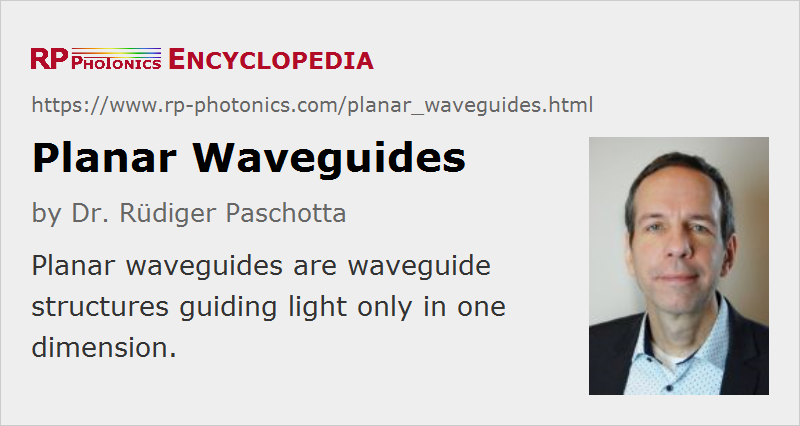Planar Waveguides
Definition: waveguide structures guiding light only in one dimension
Alternative term: slab waveguides
More general term: waveguides
German: ebene Wellenleiter
Categories:  fiber optics and waveguides,
fiber optics and waveguides,  photonic devices
photonic devices
Author: Dr. Rüdiger Paschotta
Cite the article using its DOI: https://doi.org/10.61835/ui1
Get citation code: Endnote (RIS) BibTex plain textHTML
Planar waveguides, also called slab waveguides, are waveguides with a planar geometry, which guide light only in one dimension. They are often fabricated in the form of a thin transparent film with increased refractive index on some substrate, or possibly embedded between two substrate layers. For example, a thin neodymium-doped YAG layer can be embedded in undoped YAG with slightly lower refractive index (see Figure 1). Advantages of that more symmetric design are a symmetric shape of the waveguide mode and the easier realization of single-mode waveguiding.

A waveguide function can also be achieved by diffusion of an index-raising agent into a surface, often achieved by treatment in an oven. The resulting refractive index profile is then usually not a step-index profile, but one with a smooth shape.
Active planar waveguides are sometimes used e.g. for optical amplifiers with high gain (compared with that of bulk amplifiers), relatively high output power (at least multiple watts) and high beam quality at least in one dimension. Some of these devices can be side pumped with a proximity-coupled laser diode, not requiring any pump optics.
There are also planar waveguide lasers, using reflecting end surfaces, e.g. using the Fresnel reflections.
More to Learn
Encyclopedia articles:
Suppliers
Bibliography
| [1] | A. W. Snyder and J. D. Love, Optical Waveguide Theory, Chapman and Hall, London (1983) |
Questions and Comments from Users
Here you can submit questions and comments. As far as they get accepted by the author, they will appear above this paragraph together with the author’s answer. The author will decide on acceptance based on certain criteria. Essentially, the issue must be of sufficiently broad interest.
Please do not enter personal data here; we would otherwise delete it soon. (See also our privacy declaration.) If you wish to receive personal feedback or consultancy from the author, please contact him, e.g. via e-mail.
By submitting the information, you give your consent to the potential publication of your inputs on our website according to our rules. (If you later retract your consent, we will delete those inputs.) As your inputs are first reviewed by the author, they may be published with some delay.




Share this with your friends and colleagues, e.g. via social media:
These sharing buttons are implemented in a privacy-friendly way!